JACS文献
- 格式:pdf
- 大小:1.34 MB
- 文档页数:4
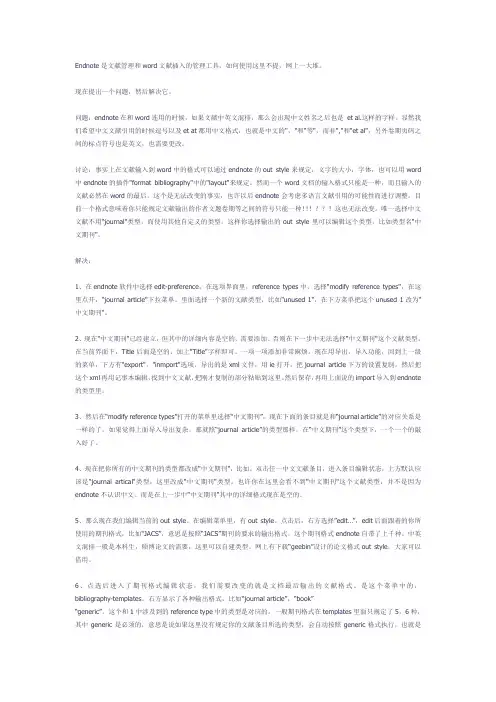
Endnote是文献管理和word文献插入的管理工具,如何使用这里不提,网上一大堆。
现在提出一个问题,然后解决它。
问题:endnote在和word连用的时候,如果文献中英文混排,那么会出现中文姓名之后也是et al.这样的字样。
显然我们希望中文文献引用的时候逗号以及et at都用中文格式,也就是中文的","和"等",而非","和"et al",另外卷期页码之间的标点符号也是英文,也需要更改。
讨论:事实上在文献输入到word中的格式可以通过endnote的out style来规定,文字的大小,字体,也可以用word 中endnote的插件"format bibliography"中的"layout"来规定。
然而一个word文档的输入格式只能是一种,而且输入的文献必然在word的最后。
这个是无法改变的事实,也许以后endnote会考虑多语言文献引用的可能性而进行调整。
目前一个格式意味着你只能规定文献输出的作者文题卷期等之间的符号只能一种!!!???这也无法改变。
唯一选择中文文献不用"journal"类型,而使用其他自定义的类型。
这样你选择输出的out style里可以编辑这个类型。
比如类型名"中文期刊"。
解决:1、在endnote软件中选择edit-preference,在选项界面里,reference types中,选择"modify reference types",在这里点开,"journal article"下拉菜单。
里面选择一个新的文献类型,比如"unused 1",在下方菜单把这个unused 1改为"中文期刊"。
2、现在"中文期刊"已经建立,但其中的详细内容是空的,需要添加。
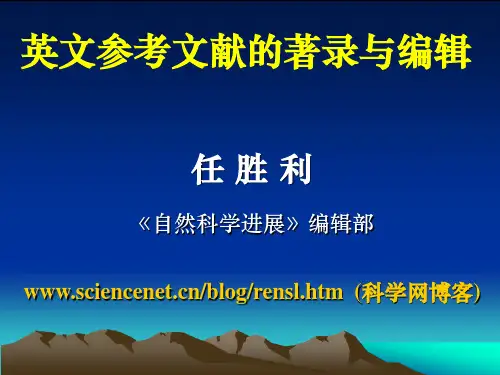
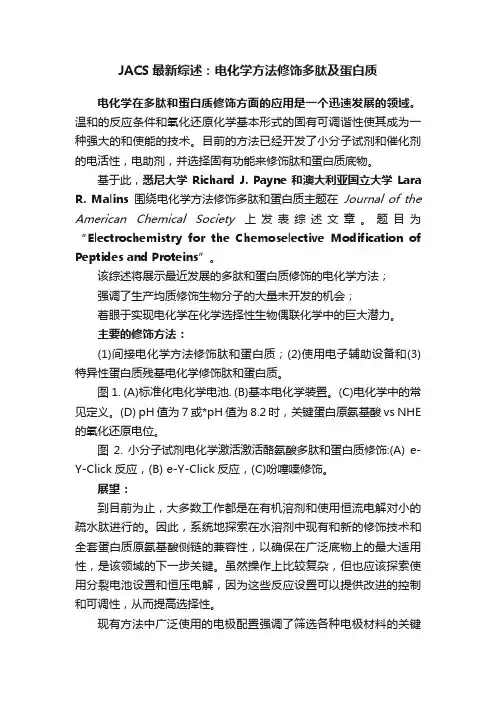
JACS最新综述:电化学方法修饰多肽及蛋白质电化学在多肽和蛋白质修饰方面的应用是一个迅速发展的领域。
温和的反应条件和氧化还原化学基本形式的固有可调谐性使其成为一种强大的和使能的技术。
目前的方法已经开发了小分子试剂和催化剂的电活性,电助剂,并选择固有功能来修饰肽和蛋白质底物。
基于此,悉尼大学Richard J. Payne和澳大利亚国立大学Lara R. Malins围绕电化学方法修饰多肽和蛋白质主题在Journal of the American Chemical Society上发表综述文章。
题目为“Electrochemistry for the Chemoselective Modification of Peptides and Proteins”。
该综述将展示最近发展的多肽和蛋白质修饰的电化学方法;强调了生产均质修饰生物分子的大量未开发的机会;着眼于实现电化学在化学选择性生物偶联化学中的巨大潜力。
主要的修饰方法:(1)间接电化学方法修饰肽和蛋白质;(2)使用电子辅助设备和(3)特异性蛋白质残基电化学修饰肽和蛋白质。
图1. (A)标准化电化学电池. (B)基本电化学装置。
(C)电化学中的常见定义。
(D) pH值为7或*pH值为8.2时,关键蛋白原氨基酸vs NHE 的氧化还原电位。
图2. 小分子试剂电化学激活激活酪氨酸多肽和蛋白质修饰:(A) e-Y-Click反应,(B) e-Y-Click反应,(C)吩噻嗪修饰。
展望:到目前为止,大多数工作都是在有机溶剂和使用恒流电解对小的疏水肽进行的。
因此,系统地探索在水溶剂中现有和新的修饰技术和全套蛋白质原氨基酸侧链的兼容性,以确保在广泛底物上的最大适用性,是该领域的下一步关键。
虽然操作上比较复杂,但也应该探索使用分裂电池设置和恒压电解,因为这些反应设置可以提供改进的控制和可调性,从而提高选择性。
现有方法中广泛使用的电极配置强调了筛选各种电极材料的关键重要性,以探测反应的选择性和最大限度地提高产量。
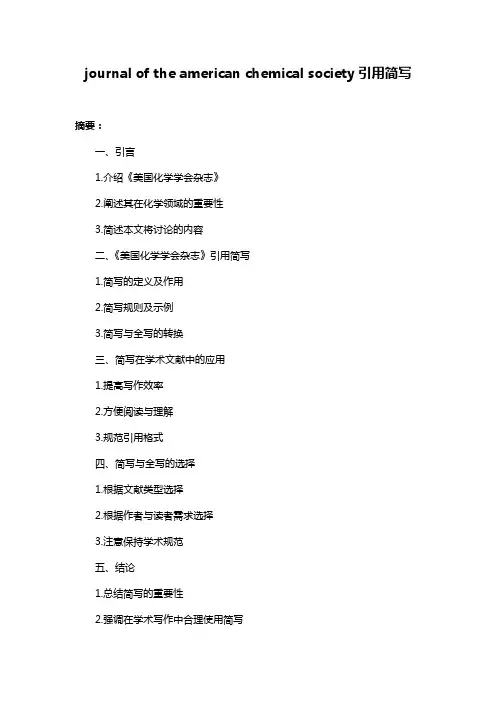
journal of the american chemical society引用简写摘要:一、引言1.介绍《美国化学学会杂志》2.阐述其在化学领域的重要性3.简述本文将讨论的内容二、《美国化学学会杂志》引用简写1.简写的定义及作用2.简写规则及示例3.简写与全写的转换三、简写在学术文献中的应用1.提高写作效率2.方便阅读与理解3.规范引用格式四、简写与全写的选择1.根据文献类型选择2.根据作者与读者需求选择3.注意保持学术规范五、结论1.总结简写的重要性2.强调在学术写作中合理使用简写3.展望简写在化学领域的未来发展趋势正文:《美国化学学会杂志》(Journal of the American Chemical Society,简称JACS)是化学领域具有重要影响力的学术期刊,发表了许多关于化学研究的原创性论文。
在学术研究中,为了提高写作效率和方便读者阅读与理解,作者们常常使用引用简写。
本文将围绕《美国化学学会杂志》的引用简写展开讨论。
首先,我们需要了解简写的定义及作用。
简写是学术文献中常用的一种写作手法,通过用缩写或首字母代替全名,以减少文字篇幅。
在《美国化学学会杂志》中,简写可以帮助作者更快地完成论文写作,同时便于读者快速理解相关概念。
其次,《美国化学学会杂志》中简写的规则及示例。
通常,简写遵循以下规则:首次全写,再次出现时使用简写。
例如,在全写“美国化学学会”(American Chemical Society,ACS)后,再次出现时可以简写为“ACS”。
需要注意的是,在首次使用简写时,需要在括号内注明全名。
此外,简写与全写之间的转换。
当文章中出现简写时,读者可能不熟悉其全写形式。
因此,在文章中需要不时进行简写与全写之间的转换,以确保读者能够理解。
例如,在简写“JACS”后,适时插入全写“Journal of the American Chemical Society”,以帮助读者建立联系。
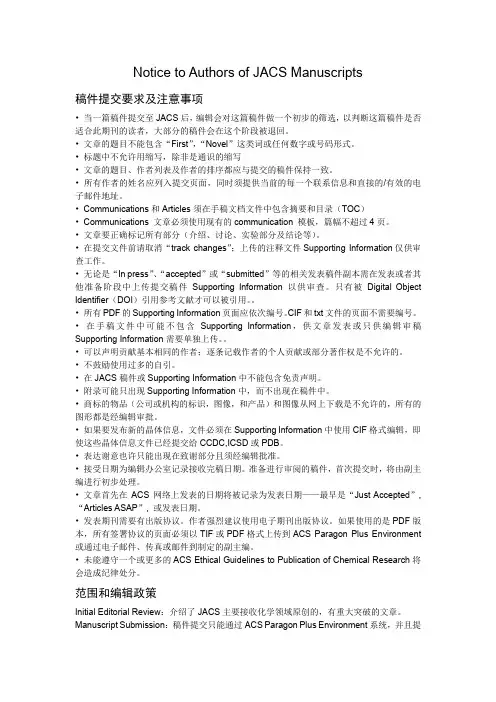
Notice to Authors of JACS Manuscripts稿件提交要求及注意事项•当一篇稿件提交至JACS后,编辑会对这篇稿件做一个初步的筛选,以判断这篇稿件是否适合此期刊的读者,大部分的稿件会在这个阶段被退回。
•文章的题目不能包含“First”,“Novel”这类词或任何数字或号码形式。
•标题中不允许用缩写,除非是通识的缩写•文章的题目、作者列表及作者的排序都应与提交的稿件保持一致。
•所有作者的姓名应列入提交页面,同时须提供当前的每一个联系信息和直接的/有效的电子邮件地址。
•Communications和Articles须在手稿文档文件中包含摘要和目录(TOC)•Communications 文章必须使用现有的communication 模板,篇幅不超过4页。
•文章要正确标记所有部分(介绍、讨论、实验部分及结论等)。
•在提交文件前请取消“track changes”;上传的注释文件Supporting Information仅供审查工作。
•无论是“In press”、“accepted”或“submitted”等的相关发表稿件副本需在发表或者其他准备阶段中上传提交稿件Supporting Information以供审查。
只有被Digital Object Identifier(DOI)引用参考文献才可以被引用。
•所有PDF的Supporting Information页面应依次编号。
CIF和txt文件的页面不需要编号。
•在手稿文件中可能不包含Supporting Information,供文章发表或只供编辑审稿Supporting Information需要单独上传。
•可以声明贡献基本相同的作者;逐条记载作者的个人贡献或部分著作权是不允许的。
•不鼓励使用过多的自引。
•在JACS稿件或Supporting Information中不能包含免责声明。
•附录可能只出现Supporting Information中,而不出现在稿件中。
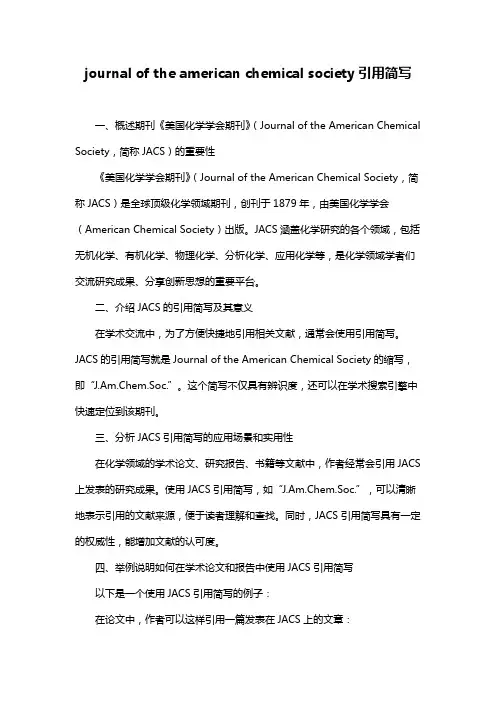
journal of the american chemical society引用简写一、概述期刊《美国化学学会期刊》(Journal of the American Chemical Society,简称JACS)的重要性《美国化学学会期刊》(Journal of the American Chemical Society,简称JACS)是全球顶级化学领域期刊,创刊于1879年,由美国化学学会(American Chemical Society)出版。
JACS涵盖化学研究的各个领域,包括无机化学、有机化学、物理化学、分析化学、应用化学等,是化学领域学者们交流研究成果、分享创新思想的重要平台。
二、介绍JACS的引用简写及其意义在学术交流中,为了方便快捷地引用相关文献,通常会使用引用简写。
JACS的引用简写就是Journal of the American Chemical Society的缩写,即“J.Am.Chem.Soc.”。
这个简写不仅具有辨识度,还可以在学术搜索引擎中快速定位到该期刊。
三、分析JACS引用简写的应用场景和实用性在化学领域的学术论文、研究报告、书籍等文献中,作者经常会引用JACS 上发表的研究成果。
使用JACS引用简写,如“J.Am.Chem.Soc.”,可以清晰地表示引用的文献来源,便于读者理解和查找。
同时,JACS引用简写具有一定的权威性,能增加文献的认可度。
四、举例说明如何在学术论文和报告中使用JACS引用简写以下是一个使用JACS引用简写的例子:在论文中,作者可以这样引用一篇发表在JACS上的文章:“近年来,研究者们对金属有机框架材料(Metal-Organic Frameworks,简称MOFs)的研究兴趣不断增加。
据报道,MOFs具有很高的比表面积和可调变的组成,因此在气体吸附、分离和储存等方面具有广泛的应用前景(J.Am.Chem.Soc., 2018, 140, 10916-10918)。
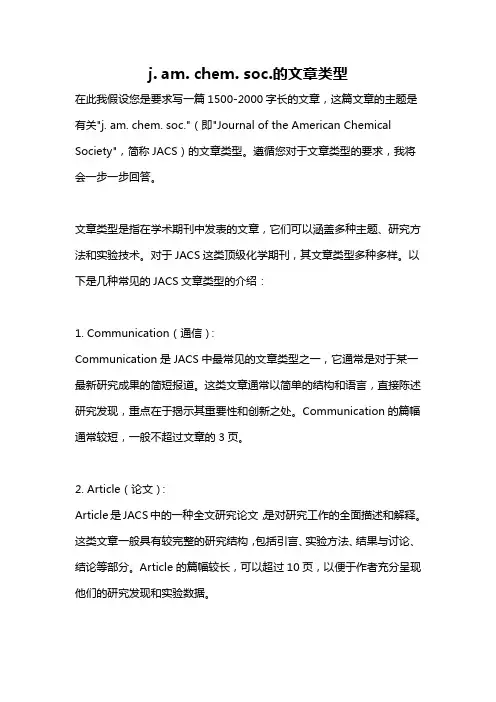
j. am. chem. soc.的文章类型在此我假设您是要求写一篇1500-2000字长的文章,这篇文章的主题是有关"j. am. chem. soc."(即"Journal of the American Chemical Society",简称JACS)的文章类型。
遵循您对于文章类型的要求,我将会一步一步回答。
文章类型是指在学术期刊中发表的文章,它们可以涵盖多种主题、研究方法和实验技术。
对于JACS这类顶级化学期刊,其文章类型多种多样。
以下是几种常见的JACS文章类型的介绍:1. Communication(通信):Communication是JACS中最常见的文章类型之一,它通常是对于某一最新研究成果的简短报道。
这类文章通常以简单的结构和语言,直接陈述研究发现,重点在于揭示其重要性和创新之处。
Communication的篇幅通常较短,一般不超过文章的3页。
2. Article(论文):Article是JACS中的一种全文研究论文,是对研究工作的全面描述和解释。
这类文章一般具有较完整的研究结构,包括引言、实验方法、结果与讨论、结论等部分。
Article的篇幅较长,可以超过10页,以便于作者充分呈现他们的研究发现和实验数据。
3. Perspective(展望):Perspective是JACS中的一类综述性文章,旨在对某一领域的最新进展进行总结和评价。
这类文章不仅会回顾过去的研究成果,还会展望未来的发展方向。
Perspective的篇幅通常较长,一般在5-20页之间。
4. Review(综述):Review是一种详尽综述性的文章类型,主要回顾和总结某一领域内的大量研究成果,以系统性的方式评估和综合现有的文献。
这类文章的目的是为读者提供对该领域广泛了解。
Review的篇幅往往很长,可以超过30页。
5. Feature Article(专题文章):Feature Article是JACS中的一类重要文章,它涉及到某一研究领域的深入探讨并提供了新的见解。
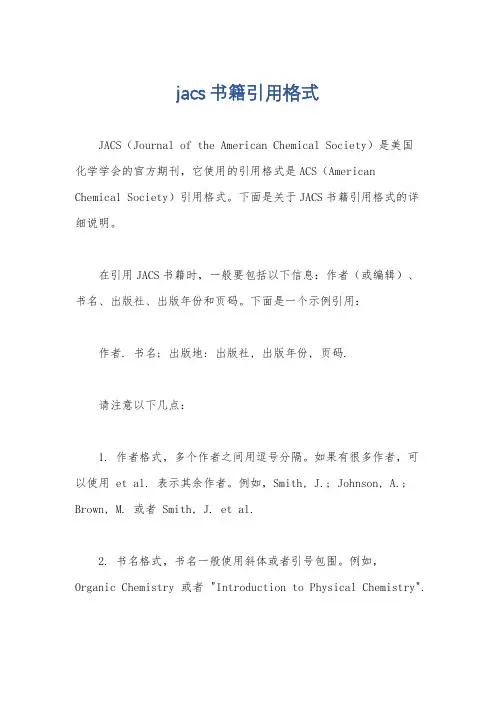
jacs书籍引用格式JACS(Journal of the American Chemical Society)是美国化学学会的官方期刊,它使用的引用格式是ACS(American Chemical Society)引用格式。
下面是关于JACS书籍引用格式的详细说明。
在引用JACS书籍时,一般要包括以下信息:作者(或编辑)、书名、出版社、出版年份和页码。
下面是一个示例引用:作者. 书名; 出版地: 出版社, 出版年份, 页码.请注意以下几点:1. 作者格式,多个作者之间用逗号分隔。
如果有很多作者,可以使用 et al. 表示其余作者。
例如,Smith, J.; Johnson, A.; Brown, M. 或者 Smith, J. et al.2. 书名格式,书名一般使用斜体或者引号包围。
例如,Organic Chemistry 或者 "Introduction to Physical Chemistry".3. 出版地和出版社,出版地指的是书籍的出版地点,例如纽约、伦敦等。
出版社是指出版该书籍的出版公司,例如Wiley、Elsevier等。
4. 出版年份,书籍的出版年份。
5. 页码,如果你引用的是书籍中的特定页码或者章节,需要提供页码范围或者具体章节的编号。
下面是一个具体的示例引用:Smith, J.; Johnson, A.; Brown, M. Organic Chemistry; New York: Wiley, 2010, pp 45-48.这个引用示例中,Smith, J.; Johnson, A.; Brown, M. 是书籍的作者,Organic Chemistry 是书名,New York 是出版地,Wiley 是出版社,2010 是出版年份,pp 45-48 是引用的页码范围。
希望以上解释对你有所帮助,如果你还有其他问题,请随时提问。
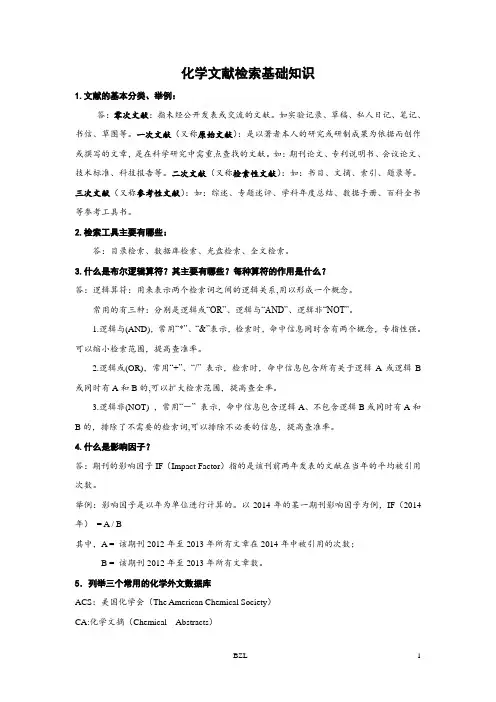
化学文献检索基础知识1.文献的基本分类、举例:答:零次文献:指未经公开发表或交流的文献。
如实验记录、草稿、私人日记、笔记、书信、草图等。
一次文献(又称原始文献):是以著者本人的研究或研制成果为依据而创作或撰写的文章,是在科学研究中需重点查找的文献。
如:期刊论文、专利说明书、会议论文、技术标准、科技报告等。
二次文献(又称检索性文献):如:书目、文摘、索引、题录等。
三次文献(又称参考性文献):如:综述、专题述评、学科年度总结、数据手册、百科全书等参考工具书。
2.检索工具主要有哪些:答:目录检索、数据库检索、光盘检索、全文检索。
3.什么是布尔逻辑算符?其主要有哪些?每种算符的作用是什么?答:逻辑算符:用来表示两个检索词之间的逻辑关系,用以形成一个概念。
常用的有三种:分别是逻辑或“OR”、逻辑与“AND”、逻辑非“NOT”。
1.逻辑与(AND),常用“*”、“&”表示,检索时,命中信息同时含有两个概念,专指性强。
可以缩小检索范围,提高查准率。
2.逻辑或(OR),常用“+”、“/” 表示,检索时,命中信息包含所有关于逻辑A或逻辑B 或同时有A和B的,可以扩大检索范围,提高查全率。
3.逻辑非(NOT) ,常用“-” 表示,命中信息包含逻辑A、不包含逻辑B或同时有A和B的,排除了不需要的检索词,可以排除不必要的信息,提高查准率。
4.什么是影响因子?答:期刊的影响因子IF(Impact Factor)指的是该刊前两年发表的文献在当年的平均被引用次数。
举例:影响因子是以年为单位进行计算的。
以2014年的某一期刊影响因子为例,IF(2014年)= A / B其中,A = 该期刊2012年至2013年所有文章在2014年中被引用的次数;B = 该期刊2012年至2013年所有文章数。
5.列举三个常用的化学外文数据库ACS:美国化学会(The American Chemical Society)CA:化学文摘(Chemical Abstracts)Science Direct: 科学指引(数据库)6.常用文献搜索工具:SciFinder、Web of Science、CNKI( 中国知网)7.化学类期刊:综合类:Nature、Science、Chemical Review等;还有JACS( Journal of the American Chemistry Society)、Angewandte Chemie-International Edition、Chemical Comminucations等。
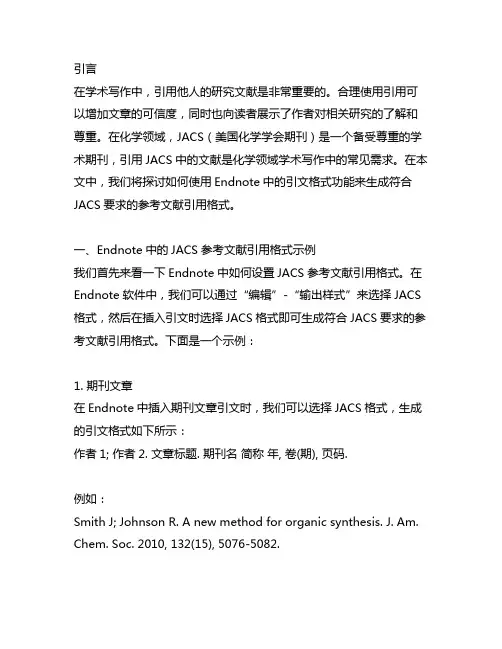
引言在学术写作中,引用他人的研究文献是非常重要的。
合理使用引用可以增加文章的可信度,同时也向读者展示了作者对相关研究的了解和尊重。
在化学领域,JACS(美国化学学会期刊)是一个备受尊重的学术期刊,引用JACS中的文献是化学领域学术写作中的常见需求。
在本文中,我们将探讨如何使用Endnote中的引文格式功能来生成符合JACS要求的参考文献引用格式。
一、Endnote中的JACS参考文献引用格式示例我们首先来看一下Endnote中如何设置JACS参考文献引用格式。
在Endnote软件中,我们可以通过“编辑”-“输出样式”来选择JACS 格式,然后在插入引文时选择JACS格式即可生成符合JACS要求的参考文献引用格式。
下面是一个示例:1. 期刊文章在Endnote中插入期刊文章引文时,我们可以选择JACS格式,生成的引文格式如下所示:作者1; 作者2. 文章标题. 期刊名简称年, 卷(期), 页码.例如:Smith J; Johnson R. A new method for organic synthesis. J. Am. Chem. Soc. 2010, 132(15), 5076-5082.2. 书籍对于书籍的引文,同样可以选择JACS格式来生成符合要求的参考文献引用格式。
格式示例如下:作者. 书名, 版本, 出版地: 出版社, 出版年.例如:McMurry J. Organic Chemistry, 9th ed.; Belmont, CA:Brooks/Cole, 2016.3. 硕博士论文对于硕博士论文的引文,也可以选择JACS格式来生成相应的引文格式。
示例如下:作者. 论文题目. 学位类型, 学校名称, 出版年.例如:Li S. Development of novel catalytic reactions. Ph.D. Thesis, University of California, 2018.以上是在Endnote中使用JACS格式生成参考文献引文的示例,可以看到,通过Endnote软件的功能,可以轻松生成符合JACS要求的参考文献引用格式。
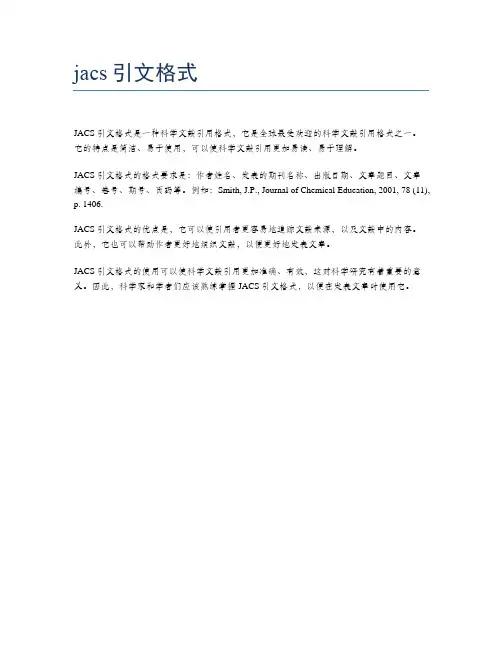
jacs引文格式
JACS引文格式是一种科学文献引用格式,它是全球最受欢迎的科学文献引用格式之一。
它的特点是简洁、易于使用,可以使科学文献引用更加易读、易于理解。
JACS引文格式的格式要求是:作者姓名、发表的期刊名称、出版日期、文章题目、文章编号、卷号、期号、页码等。
例如:Smith, J.P., Journal of Chemical Education, 2001, 78 (11), p. 1406.
JACS引文格式的优点是,它可以使引用者更容易地追踪文献来源,以及文献中的内容。
此外,它也可以帮助作者更好地组织文献,以便更好地发表文章。
JACS引文格式的使用可以使科学文献引用更加准确、有效,这对科学研究有着重要的意义。
因此,科学家和学者们应该熟练掌握JACS引文格式,以便在发表文章时使用它。
Published:May 12,2011COMMUNICATION /JACSInterface-Directed Assembly of One-Dimensional Ordered Architecture from Quantum Dots Guest and Polymer HostShengyang Yang,Cai-Feng Wang,and Su Chen*State Key Laboratory of Materials-Oriented Chemical Engineering,and College of Chemistry and Chemical Engineering,Nanjing University of Technology,Nanjing 210009,P.R.ChinabSupporting Information ABSTRACT:Assembly of inorganic semiconductor nano-crystals into polymer host is of great scienti fic and techno-logical interest for bottom-up fabrication of functional devices.Herein,an interface-directed synthetic pathway to polymer-encapsulated CdTe quantum dots (QDs)has been developed.The resulting nanohybrids have a highly uniform fibrous architecture with tunable diameters (ranging from several tens of nanometers to microscale)and enhanced optical performance.This interfacial assembly strategy o ffers a versatile route to incorporate QDs into a polymer host,forming uniform one-dimensional nanomaterials po-tentially useful in optoelectronic applications.Similar to the way that atoms bond to form molecules and complexes,inorganic nanoparticles (NPs)can be combined to form larger ensembles with multidimensional ordered hier-archical architecture,evoking new collective functions.To this end,the development of the controlled self-assembly method for well-de fined structures of these ensembles is signi ficant for creating new and high-performance tunable materials and hence has aroused appealing scienti fic and industrial interest.1Particu-larly,much e ffort has been devoted to the construction of one-dimensional (1D)structures of NPs,owing in part to their application as pivotal building blocks in fabricating a new generation of optoelectronic devices.2In this context,directed host Àguest assembly of NPs into polymer matrices is an e ffective “bottom-up ”route to form 1D ordered functional materials with advantageous optical,electrical,magnetic,and mechanical properties.3Some typical routes have been developed for the generation of these 1D hybrids so far,involving template-assisted,4seeding,5and electro-static approaches.6However,the challenge still remains to precisely manipulate assembly of aqueous NPs and water-insoluble polymers into uniform 1D nanocomposites with a high aspect ratio because of phase separation and aggregation.7Moreover,facile synthetic strate-gies are highly needed to fabricate homogeneous 1D composites in which each component still preserves favorable properties to produce optimal and ideal multifunctional materials.A liquid Àliquid interface o ffers an ideal platform to e fficiently organize NPs into ordered nanostructures driven by a minimiza-tion of interfacial energy.8While much of this research has been directed toward NP hybrids with diverse morphologies based on small organic ligand-directed assembly,9some success has also been achieved in polymer-based NPs nanocomposites.10Russelland co-workers developed ultrathin membranes and capsules of quantum dots (QDs)stabilized by cross-linked polymers at the toluene/water interface.10a,11Brinker ’s group reported the fab-rication of free-standing,patternable NP/polymer monolayer arrays via interfacial NP assembly in a polymeric photoresist.12Herein,a simple host Àguest assembly route is developed to facilely create homogeneous 1D CdTe/polymer hybrids without any indication of phase separation at the aqueous/organic inter-face for the first time.The CdTe nanocrystal is a semiconductor that has been used extensively for making thin film for solar cells.13Some elegant studies have been made in synthesizing pure inorganic 1D CdTe nanowires via assembly from corre-sponding individual CdTe nanocrystals.14In this work,CdTe QDs are covalently grafted with poly(N -vinylcarbazole-co -glycidylmethacrylate)(PVK-co -PGMA)to form uniform fibrous fluorescent composites at the water/chloroform interface via the reaction between epoxy groups of PVK-co -PGMA and carboxyl groups on the surface of CdTe QDs (Scheme 1).15These 1D composite fibers can be allowed to grow further in the radial direction by “side-to-side ”assembly.Additionally,this type of interfacial QD Àpolymer assembly can observably improve the fluorescence lifetime of semiconductor QDs incorporated in theScheme 1.Schematic Representation of the Synthesis of PVK-co -PGMA/CdTe QDs Composite Nano fibersReceived:February 8,2011polymeric matrix.It can be expected that this example of both linear axial organization and radial assembly methodology can be applied to fabricate spatial multiscale organic Àinorganic com-posites with desired properties of NPs and polymers.Figure 1a shows a typical scanning electron microscope (SEM)image of PVK-co -PGMA/CdTe QDs composite nano fi-bers obtained at the water/chloroform interface after dialysis.The as-prepared fibers have uniform diameters of about 250nm and typical lengths in the range of several tens to several hundreds of micrometers (Figures 1a and S4Supporting In-formation [SI]).Interestingly,PVK-co -PGMA/CdTe composite fibers can randomly assemble into nestlike ring-shaped patterns (Figures 1b and S5[SI]).Given the interaction among epoxy groups,the formation of nestlike microstructures could be attributed to incidental “head-to-tail ”assembly of composite fibers.Moreover,in order to establish the relationship between the role of epoxy groups and the formation of composite nano fibers,control experiments were performed,in which pure PGMA or PVK was used to couple CdTe QDs.The PGMA/CdTe composites could be obtained with fibrous patterns (Figure S6[SI]),but no fibrous composites were achieved at the biphase interface with the use of PVK under the same conditions.The microstructures and fluorescence properties of PVK-co -PGMA/CdTe composite fibers were further character-ized using laser confocal fluorescence microscopy (LCFM).Confocal fluorescence micrographs of composite fibers show that the di fferently sized QDs have no obvious in fluence on the morphology of composites (Figure 1c Àe).Clearly,uniform and strong fluorescence emission is seen throughout all the samples,and the size-dependent fluorescence trait of CdTe QDs in PVK-co -PGMA matrix remains well.In order to verify the existence and distribution of CdTe QDs in the fibers,transmission electron microscopy (TEM)was employed to examine the assembled structures.Figure 2a shows a TEM image of PVK-co -PGMA/CdTe QDs composite nano fi-bers,indicating each composite fiber shown in Figure 1a was assembled from tens of fine nano fibers.An individual fine nano fiber with the diameter of about 30nm is displayed in Figure 2b,from which we can see that CdTe QDs have been well anchored into the fiber with polymeric protection layer,revealing this graft-form process at the interface e ffectively avoidednon-uniform aggregation in view of well-dispersed CdTe QDs within the composite fiber,consistent with the LCFM observa-tion.Unlike previous works where the nanoparticles were ad-sorbed onto the polymer fibers,16CdTe QDs were expelled from the surface of fibers (∼2.5nm)in our system (Figure 2c),albeit the high percentage of QDs in the polymer host (23wt %)was achieved (Figure S7[SI]).This peculiarity undoubtedly confers CdTe QDs with improved stability.The clear di ffuse rings in the selected area electron di ffraction (SAED)pattern further indicate excellent monodispersion and finely preserved crystalline struc-ture of QDs in the nano fibers (Figure 2d).The SAED data correspond to the cubic zinc blende structure of CdTe QDs.A possible mechanism for the assembly of 1D nanostructure was proposed,as illustrated in Figure S8[SI].The hydrophilic epoxy groups of the PVK-co -PGMA chain in the oil phase orient toward the biphase interface and then react with carboxyl groups on the surface of CdTe QDs in the aqueous phase to a fford premier PVK-co -PGMA/CdTe QDs composites.Such nanocomposites will reverse repeatedly,resulting from iterative reaccumulation of epoxy groups at the interface and the reaction between the active pieces (i.e.,epoxy or carboxyl groups)in the composites with intact CdTe QDs or PVK-co -PGMA,forming well-de fined nano-fibers.The control experiments showing that the diameter of composite fibers increases with the increase in the concentration of PVK-co -PGMA are in agreement with the proposed mechan-ism (Figure S9[SI]).In addition,it is expected that the pure polymeric layer on the surface of the fibers (red rectangular zone in Figure 2c)will allow further assembly of fine fibers into thick fibers,and these fibers also could randomly evolve into rings,forming nestlike microstructures when the “head ”and “tail ”of fibers accidentally meet (Figure 1b).To further examine the assembly behavior of composite fibers,the sample of PVK-co -PGMA/CdTe QDs composite nano fibers were kept at the water/chloroform interface for an additional month in a close spawn bottle at room temperature (Figure S10[SI]).With longer time for assembly,thicker composite fibers with tens of micrometers in diameter were obtained (Figure 3a).These micro-fibers have a propensityto form twisted morphology (Figure 3a,b),Figure 1.(a,b)SEM images of PVK-co -PGMA/CdTe QDs composite nano fibers.(c Àe)Fluorescence confocal microscopy images of PVK-co -PGMA/CdTe QDs composite nano fibers in the presence of di fferently sized QDs:(c)2.5nm,(d)3.3nm,and (e)3.6nm.The excitation wavelengths are 488(c),514(d),and 543nm (e),respectively.Figure 2.(a,b)TEM images of PVK-co -PGMA/CdTe QDs composite nano fibers,revealing composite nano fiber assemblies.(c)HRTEM image and (d)SAED pattern of corresponding PVK-co -PGMA/CdTe QDs composite nano fibers.while their re fined nanostructures still reveal relatively parallel character and con firm the micro fibers are assembled from countless corresponding nano fibers (Figure 3c).The corresponding LCFM image of an individual micro fiber is shown in Figure 3d (λex =488nm),indicating strong and homogeneous green fluorescence.Another indication is the fluorescent performance of PVK-co -PGMA/CdTe QDs composite micro fibers (Figure 4a).The fluorescent spectrum of composite fibers takes on emission of both PVK-co -PGMA and CdTe QDs,which suggests that this interfacial assembly route is e ffective in integrating the properties of organic polymer and inorganic nanoparticles.It is worth noting that there is a blue-shift (from 550to 525nm)and broadening of the emission peak for CdTe QDs upon their incorporation into polymeric hosts,which might be ascribed to the smaller QD size and less homogeneous QD size distribution resulting from the photooxidation of QD surfaces.17Since the emission spectra of PVK-co -PGMA spectrally overlap with the CdTe QD absorption (Figure S11[SI]),energy transfer from the copolymer to the CdTe QDs should exist.18However,the photoluminescence of PVK-co -PGMA does not vanish greatly in the tested sample in comparison with that of polymer alone,revealing inferior energy transfer between the polymer host and the QDs.Although e fficient energy transfer could lead to hybrid materials that bring together the properties of all ingredients,18it is a great hurdle to combine and keep the intrinsic features of all constituents.19In addition,by changing the polymeric compo-nent and tailoring the element and size of QDs,it should be possible to expect the integration of organic and inorganic materials with optimum coupling in this route for optoelectronic applications.Finally,to assess the stability of CdTe QDs in the composite micro fibers,time-resolved photoluminescence was performed using time-correlated single-photon counting (TCSPC)parative TCSPC studies for hybrid PVK-co -PGMA/CdTe QDs fibers and isolated CdTe QDs in the solid state are presented in Figure 4b.We can see that the presence of PVK-co -PGMA remarkably prolongs the fluorescence lifetime (τ)of CdTe QDs.Decay traces for the samples were well fittedwith biexponential function Y (t )based on nonlinear least-squares,using the following expression.20Y ðt Þ¼R 1exp ðÀt =τ1ÞþR 2exp ðÀt =τ2Þð1Þwhere R 1,R 2are fractional contributions of time-resolved decaylifetimes τ1,τ2and the average lifetime τhcould be concluded from the eq 2:τ¼R 1τ21þR 2τ22R 1τ1þR 2τ2ð2ÞFor PVK-co -PGMA/CdTe QDs system,τh is 10.03ns,which is approximately 2.7times that of isolated CdTe QDs (3.73ns).Photooxidation of CdTe QDs during the assembly process can increase the surface states of QDs,causing a delayed emission upon the carrier recombination.21Also,the polymer host in this system could prevent the aggregation of QDs,avoid self-quench-ing,and delay the fluorescence decay process.22The increased fluorescence lifetime could be also ascribed to energy transfer from PVK-co -PGMA to CdTe QDs.18c The result suggests that this host Àguest assembly at the interface could find signi ficant use in the fabrication of QDs/polymer hybrid optoelectronic devices.In summary,we have described the first example of liquid/liquid interfacial assembly of 1D ordered architecture with the incorporation of the QDs guest into the polymer host.The resulting nanohybrids show a highly uniform fibrous architecture with tunable diameter ranging from nanoscale to microscale.The procedure not only realizes the coexistence of favorable properties of both components but also enables the fluorescence lifetime of QDs to be enhanced.This interesting development might find potential application for optoelectronic and sensor devices due to high uniformity of the 1D structure.Further e fforts paid on optimal regulation of QDs and polymer composition into 1D hybrid nanostructure could hold promise for the integration of desirable properties of organic and inorganic compositions for versatile dimension-dependent applications.In addition,this facile approach can be easily applied to various semiconductor QDs and even metal NPs to develop highly functional 1D nanocomposites.’ASSOCIATED CONTENTbSupporting Information.Experimental details,FT-IR,GPC,UV Àvis,PL,SEM,TGA analysis,and complete ref 9c.This material is available free ofcharge via the Internet at .Figure 3.(a,b)SEM and (c)FESEM images of PVK-co -PGMA/CdTe QDs composite micro fibers.(d)Fluorescence confocal microscopy images of PVK-co -PGMA/CdTe QDs composite micro fibers inthe presence of green-emitting QDs (2.5nm).Figure 4.(a)Fluorescence spectra of PVK-co -PGMA,CdTe QD aqueous solution,and PVK-co -PGMA/CdTe QDs composite micro-fibers.(b)Time-resolved fluorescence decay curves of CdTe QDs (2.5nm diameter)powders (black curve)and the corresponding PVK-co -PGMA/CdTe QDs composite micro fibers (green curve)mea-sured at an emission peak maxima of 550nm.The samples were excited at 410nm.Biexponential decay function was used for satisfactory fitting in two cases (χ2<1.1).’AUTHOR INFORMATIONCorresponding Authorchensu@’ACKNOWLEDGMENTThis work was supported by the National Natural Science Foundation of China(21076103and21006046),National Natural Science Foundation of China-NSAF(10976012),the Natural Science Foundations for Jiangsu Higher Education Institutions of China(07KJA53009,09KJB530005and10KJB5 30006),and the Priority Academic Program Development of Jiangsu Higher Education Institutions(PAPD).’REFERENCES(1)(a)Kashiwagi,T.;Du,F.;Douglas,J.F.;Winey,K.I.;Harris, R.H.;Shields,J.R.Nat.Mater.2005,4,928.(b)Shenhar,R.;Norsten, T.B.;Rotello,V.M.Adv.Mater.2005,17,657.(c)Akcora,P.;Liu,H.; Kumar,S.K.;Moll,J.;Li,Y.;Benicewicz,B.C.;Schadler,L.S.;Acehan, D.;Panagiotopoulos,A.Z.;Pryamitsyn,V.;Ganesan,V.;Ilavsky,J.; Thiyagarajan,P.;Colby,R.H.;Douglas,J.F.Nat.Mater.2009,8,354.(d)Dayal,S.;Kopidakis,N.;Olson,D.C.;Ginley,D.S.;Rumbles,G. J.Am.Chem.Soc.2009,131,17726.(e)Lin,Y.;B€o ker,A.;He,J.;Sill,K.; Xiang,H.;Abetz,C.;Li,X.;Wang,J.;Emrick,T.;Long,S.;Wang,Q.; Balazs,A.;Russell,T.P.Nature2005,434,55.(f)Park,S.;Lim,J.ÀH.; Chung,S.W.;Mirkin,C.A.Science2004,303,348.(g)Mai,Y.; Eisenberg,A.J.Am.Chem.Soc.2010,132,10078.(h)Mallavajula, R.K.;Archer,L.A.Angew.Chem.,Int.Ed.2011,50,578.(i)Kim,J.;Piao, Y.;Hyeon,T.Chem.Soc.Rev.2009,38,372.(2)(a)Xia,Y.;Yang,P.;Sun,Y.;Wu,Y.;Mayers,B.;Gates,B.;Yin, Y.;Kim,F.;Yan,H.Adv.Mater.2003,15,353.(b)Lu,X.;Wang,C.;Wei, Y.Small2009,5,2349.(c)Nie,Z.;Fava,D.;Kumacheva,E.;Zou,S.; Walker,G.C.;Rubinstein,M.Nat.Mater.2007,6,609.(3)(a)Huynh,W.U.;Dittmer,J.J.;Alivisatos,A.P.Science2002, 295,2425.(b)Balazs,A.C.;Emrick,T.;Russell,T.P.Science2006, 314,1107.(c)Ramanathan,T.;Abdala,A.A.;Stankovich,S.;Dikin, D.A.;Herrera-Alonso,M.;Piner,R.D.;Adamson,D.H.;Schniepp, H.C.;Chen,X.;Ruoff,R.S.;Nguyen,S.T.;Aksay,I.A.;Prud’homme, R.K.;Brinson,L.C.Nat.Nanotechnol.2008,3,327.(d)Tomczak,N.; Janczewski,D.;Han,M.;Vancso,G.J.Prog.Polym.Sci.2009,34,393.(e)Zhao,Y.;Thorkelsson,K.;Mastroianni,A.J.;Schilling,T.;Luther, J.M.;Rancatore,B.J.;Matsunaga,K.;Jinnai,H.;Wu,Y.;Poulsen,D.; Frechet,J.M.J.;Alivisatos,A.P.;Xu,T.Nat.Mater.2009,8,979.(f) Colfen,H.;Mann,S.Angew.Chem.,Int.Ed.2003,42,2350.(g)Sone,E.D.;Stupp,S.I.J.Am.Chem.Soc.2004,126,12756.(4)Chan,C.S.;De Stasio,G.;Welch,S.A.;Girasole,M.;Frazer,B.H.;Nesterova,M.V.;Fakra,S.;Banfield,J.F.Science2004,303,1656.(5)Tran,H.D.;Li,D.;Kaner,R.B.Adv.Mater.2009,21,1487.(6)Yuan,J.;M€u ller,A.H.E.Polymer2010,51,4015.(7)(a)Greenham,N.C.;Peng,X.;Alivisatos,A.P.Phys.Rev.B 1996,54,17628.(b)Lopes,W.A.;Jaeger,H.M.Nature2001,414,735.(c)Gupta,S.;Zhang,Q.;Emrick,T.;Balazs,A.Z.;Russell,T.P.Nat. Mater.2006,5,229.(8)(a)Wang,X.;Zhuang,J.;Peng,Q.;Li,Y.Nature2005,437,121.(b)Huang,J.;Kaner,R.B.J.Am.Chem.Soc.2004,126,851.(c)Binder, W.H.Angew.Chem.,Int.Ed.2005,44,5172.(d)Capito,R.M.;Azevedo, H.S.;Velichko,Y.S.;Mata,A.;Stupp,S.I.Science2008,319,1812.(e)Yin,Y.;Skaff,H.;Emrick,T.;Dinsmore,A.D.;Russell,T.P.Science 2003,299,226.(f)Arumugam,P.;Patra,D.;Samanta,B.;Agasti,S.S.; Subramani,C.;Rotello,V.M.J.Am.Chem.Soc.2008,130,10046.(g)Hou,L.;Wang,C.F.;Chen,L.;Chen,S.J.Mater.Chem.2010, 20,3863.(9)(a)Duan,H.;Wang,D.;Kurth,D.G.;Mohwald,H.Angew. Chem.,Int.Ed.2004,43,5639.(b)B€o ker,A.;He,J.;Emrick,T.;Russell,T.P.Soft Matter2007,3,1231.(c)Russell,J.T.;et al.Angew.Chem.,Int. Ed.2005,44,2420.(10)(a)Lin,Y.;Skaff,H.;B€o ker,A.;Dinsmore,A.D.;Emrick,T.; Russell,T.P.J.Am.Chem.Soc.2003,125,12690.(b)B€o ker,A.;Lin,Y.; Chiapperini,K.;Horowitz,R.;Thompson,M.;Carreon,V.;Xu,T.; Abetz,C.;Skaff,H.;Dinsmore,A.D.;Emrick,T.;Russell,T.P.Nat. Mater.2004,3,302.(11)Skaff,H.;Lin,Y.;Tangirala,R.;Breitenkamp,K.;B€o ker,A.; Russell,T.P.;Emrick,T.Adv.Mater.2005,17,2082.(12)Pang,J.;Xiong,S.;Jaeckel,F.;Sun,Z.;Dunphy,D.;Brinker,C.J.J.Am.Chem.Soc.2008,130,3284.(13)Fulop,G.;Doty,M.;Meyers,P.;Betz,J.;Liu,C.H.Appl.Phys. Lett.1982,40,327.(14)(a)Tang,Z.;Kotov,N.A.;Giersig,M.Science2002,297,237.(b)Zhang,H.;Wang,D.;Yang,B.;M€o hwald,H.J.Am.Chem.Soc.2006, 128,10171.(c)Yang,P.;Ando,M.;Murase,N.Adv.Mater.2009, 21,4016.(d)Srivastava,S.;Santos,A.;Critchley,K.;Kim,K.-S.; Podsiadlo,P.;Sun,K.;Lee,J.;Xu,C.;Lilly,G.D.;Glotzer,S.C.;Kotov, N.A.Science2010,327,1355.(15)Reis,A.V.;Fajardo,A.R.;Schuquel,I.T.A.;Guilherme,M.R.; Vidotti,G.J.;Rubira,A.F.;Muniz,.Chem.2009,74,3750.(16)(a)Djalali,R.;Chen,Y.;Matsui,H.J.Am.Chem.Soc.2002, 124,13660.(b)George,J.;Thomas,K.G.J.Am.Chem.Soc.2010, 132,2502.(17)(a)Yang,S.;Li,Q.;Chen,L.;Chen,S.J.Mater.Chem.2008, 18,5599.(b)Wang,Y.;Herron,N.J.Phys.Chem.1991,95,525.(c)Zhang,Y.;He,J.;Wang,P.N.;Chen,J.Y.;Lu,Z.J.;Lu,D.R.;Guo,J.; Wang,C.C.;Yang,W.L.J.Am.Chem.Soc.2006,128,13396.(d)Carrillo-Carri o n,C.;C a rdenas,S.;Simonet,B.M.;Valc a rcel,M. mun.2009,5214.(18)(a)Tessler,N.;Medvedev,V.;Kazes,M.;Kan,S.;Banin,U. Science2002,295,1506.(b)Zhang,Q.;Atay,T.;Tischler,J.R.;Bradley, M.S.;Bulovi c,V.;Nurmikko,A.V.Nat.Nanotechnol.2007,2,555.(c)Lutich,A.A.;Jiang,G.X.;Susha,A.S.;Rogach,A.L.;Stefani,F.D.; Feldmann,J.Nano Lett.2009,9,2636.(19)Li,M.;Zhang,J.;Zhang,H.;Liu,Y.;Wang,C.;Xu,X.;Tang,Y.; Yang,B.Adv.Funct.Mater.2007,17,3650.(20)Schr€o der,G.F.;Alexiev,U.;Grubm€u ller,H.Biophys.J.2005, 89,3757.(21)(a)Zhong,H.Z.;Zhou,Y.;Ye,M.F.;He,Y.J.;Ye,J.P.;He,C.; Yang,C.H.;Li,Y.F.Chem.Mater.2008,20,6434.(b)Sun,H.;Zhang, H.;Zhang,J.;Ning,Y.;Yao,T.;Bao,X.;Wang,C.;Li,M.;Yang,B. J.Phys.Chem.C2008,112,2317.(22)Kagan,C.R.;Murray,C.B.;Bawendi,M.G.Phys.Rev.B1996, 54,8633.。
journal of american chemistry参考文献格式
在ACS风格中,“Journal of the American Chemical Society”的引用格式大致如下:
文章中引用:
在文中引用时,通常只需给出作者的名字和发表年份。
如果同一作者在同一年有多篇文章,那么需要加上字母(a, b, c...)来区分。
例如:(Smith, 2020) 或(Smith, 2020a; Smith, 2020b)
参考文献列表:
在参考文献列表中,需要给出完整的引用信息。
对于JACS上的文章,格式通常如下:Smith, J. A.; Jones, B. C. Title of the Article. J. Am. Chem. Soc. 2020, 142, 1234−1239.
这里,“Smith, J. A.”和“Jones, B. C.”是文章的作者,“Title of the Article”是文章的标题,“J. Am. Chem. Soc.”是期刊名的缩写,“2020”是发表年份,“142”是卷号,“1234−1239”是文章的页码范围。
请注意,具体的引用格式可能会根据期刊的要求、文章的类型或您所在的学科领域而有所不同。
因此,在准备论文时,最好查阅您所投稿的期刊的“作者指南”或“投稿须知”,以确保您的引用格式符合期刊的要求。
同时,为了避免手动编排参考文献时出现错误,您可以考虑使用参考文献管理工具(如EndNote、Mendeley、Zotero等),这些工具可以帮助您自动编排和格式化参考文献。
JACS是Journal of the American Chemical Society的缩写,中文名称为《美国化学会志》。
JACS单位符号并没有一个统一的定义,因为它可以应用于不同的领域和情境。
一般来说,JACS单位符号指的是用于表示《美国化学会志》相关数据、
信息、指标等的符号或缩写。
在一些领域中,JACS单位符号可能表示期刊的影响因子、被引频次等指标,这些
指标通常用于评估期刊的质量和学术水平。
例如,在科学信息领域,影响因子和被引频次常常被用于评估期刊的学术价值,这些指标可以用相应的符号或缩写来表示。
此外,JACS单位符号还可以用于表示其他与《美国化学会志》相关的数据、信息、指标等,具体使用时应根据上下文和领域来确定其含义。
如果您想了解更多关于JACS单位符号的具体应用和含义,建议查阅相关领域的专业文献或咨询相关领域的专家。
投稿指南(中文版)Journal Publishing Agreement每篇手稿在提交时都必须正确填写并签署期刊出版协议。
一旦手稿被分配给编辑,ACS Paragon Plus提供的电子版本的协议将会在作者的通讯主页上显示My Authoring Activity选项。
该协议的PDF版本也可以使用,但强烈建议作者使用电子期刊出版的协议。
如果使用的是PDF版本,必须提交PDF签署的所有页面。
如果通讯作者不能或不应该以任何理由完成电子版或PDF版本,那么另一位作者应签署PDF版本形式。
可以在该网站获得期刊出版协议的完整的指导说明/page/copyright/journals/index.html.Cover LetterCover letter必须和稿件同时提交,可以使用Word或PDF文件创建或输入到ACS Paragon Plus Environment相应的文本框中。
信中必须提供通讯作者的姓名、邮编和电子邮件地址及电话和传真号码。
相关编辑稿件的接收、状态、审查、修订及提交的所有相关稿件将只发送给已被指定为评估稿件的通讯作者。
通讯作者负责处理和论文发表之前或者之后所有的事情并且获得合著者在修订稿件内容或诠释上做出的一些实质性建议。
投稿信可能会推荐一个合适的JACS副主编。
然而,分配给副主编的稿件最终由编辑自行决断。
作者必须建议至少六到八人主管审阅他们的稿件,其中至少一半是来自北美的评论员。
选择合适的评论员是副主编在处理稿件时的独有的权利。
投稿信应明确保证稿件没有在发表进行中,也没有在任何其他媒介中发表,包括电子期刊和公共性质的电脑资料库。
论文投稿所有稿件必须通过ACS Paragon Plus Environment发表(/login). 完整的指导说明和电子在线(网络)提交过程的概述都可以通过安全ACS Paragon Plus 网站获取信息。
同时,作者还须通过ACS Paragon Plus Environment提交所有修改的稿件。
Total Synthesis and Biological Investigation of (−)-PromysalinAndrew D.Steele,Kyle W.Knouse,Colleen E.Keohane,and William M.Wuest *Department of Chemistry,Temple University,Philadelphia,Pennsylvania 19122,United States*Supporting Information coupled with computational analysis methods have revolutionized research into microbiomes the entirety of the microbial community in a given system.1At the same time,the burgeoning field of microbial ecology has shed light on the inherent complexity of interrelationships in such ecosystems.2Studies investigating the coexistence of organisms,ranging from mutualistic to parasitic,have had a profound impact on our understanding of life,most notably in the human body.There has been a call to provide small-molecule probes that could be used to deconvolute such systems by speci fically targeting pathogenic bacteria.For example,a narrow-spectrum antibiotic that can speci fically target pathovars without disrupting the remaining population would be of interest in agriculture.If successful,these compounds would be of value not only to farming but also to human health (i.e.,oral,gastrointestinal)and other commercial interests.A well-studied example of a multispecies community is the root system of plants,generally termed the rhizosphere microbiome.3The predominant players in this arena are the Pseudomonads ,which comprise both commensal and patho-genic species competing for vital resources,either ensuring or jeopardizing the health of the host.The competitors produce an array of secondary metabolites with unique bioactivities evolutionarily designed to promote survival.Functions include siderophores,4virulence factors,5biosurfactants,6and anti-biotics.7Such species-speci fic compounds represent attractive targets for agricultural and medicinal needs and may shed light on novel virulence targets for future drug design.In 2011,De Mot and co-workers isolated a novel metabolite,promysalin (1),from Pseudomonas putida (PP )RW10S1,which resides in the rhizosphere of rice plants (Figure 1).8The natural product showed unique species-speci fic bioactivity,mostnotably against Pseudomonas aeruginosa (PA ),inhibiting growth at low-micromolar concentrations.Promysalin selectively inhibits certain PA strains and other Gram-negative bacteria but shows no activity against their Gram-positive counterparts.In contrast,the compound was also shown to promote swarming of the producing organism,hinting at two discrete modes of action.The original report characterized the biosynthetic gene cluster and proposed a biosynthesis via annotation and the characterization of shunt products.The authors elucidated the structure of promysalin through spectroscopic methods;however,no absolute or relative stereochemical assignments were made.Considering the signi ficance of PA in clinical settings 9(cystic fibrosis,immunocompromised patients)and in agriculture,promysalin could serve as an attractive alternative to current therapies.TheReceived:May 7,2015Published:May 29,2015Figure 1.Proposed biosynthesis of promysalin.Polyketide synthase (PKS),NRPS,and tailoring enzymes (Rieske iron −sulfur cluster,asparagine synthase,chorismate synthase)are depicted.unique bioactivity,unknown mode of action,and structural ambiguity are what prompted the synthesis reported herein.Before initiating our synthetic investigation,we sought to reannotate the biosynthetic gene cluster using AntiSMASH (Figure 1).10We postulated that this computational work would aid in determining the absolute stereochemistry of dehydroproline,thus limiting the synthesis to one enantiomeric series.This study con firmed that ppgJ encodes for a truncated nonribosomal peptide synthetase (NRPS)module containing both adenylation (A)and thiolation domains but lacking a condensation domain,reminiscent of sylC found in Pseudomo-nas syringae .11Upon closer inspection,we were unable to identify any putative epimerase or thioesterase domains contained in either the characterized gene cluster or the flanking regions.Bioinformatic investigation of the ppgJ A domain revealed the Stachelhaus code,12DVQFVAHV,corresponding to the selective activation of L -proline as previously hypothesized by De Mot.8This exercise led us to the conclusion that the absolute con figuration of the C16stereocenter should be assigned as (S ).On the basis of these results,we reevaluated the proposed biosynthesis of promysa-lin,which is depicted in Figure 1.With this information in hand,we began our campaign to synthesize the four diastereomers generated from the two unresolved stereocenters (C2and C8).Our synthetic e fforts began with the construction of the four diastereomers of the myristic acid fragment (Scheme 1).We envisioned utilizing a convergent route wherein cross-meta-thesis followed by hydrogenation would be used to forge the complete aliphatic chain,providing a succinct route to all four L -proline diastereomers.Beginning with the known compound (−)-2,available in one step from 5-hexenoic acid and the phenylalanine-derived Evans oxazolidinone,13diastereoselective oxidation using the Davis oxaziridine 14followed by silyl protection furnished compound (−)-4in good yield.Cross-metathesis with the known enantiomerically pure homoallylic alcohol (+)-5or (−)-5in the presence of catalyst C711,15subsequent hydrogenation,and ammonolysis provided diaster-eomers (+)-6a and (+)-6b ,respectively.Analogously,the enantiomeric series of compounds (−)-6c and (−)-6d were synthesized starting with (+)-2.This route provides concise access to all four diastereomers in enantiomerically pure form (45−54%yield over five steps).The synthesis of the proline −salicylate fragment commenced with ester hydrolysis of (2-(trimethylsilyl)ethoxy)methyl (SEM)-protected methyl salicylate,amidation with trans -4-L -hydroxyproline methyl ester,and Dess −Martin oxidation to provide (+)-9(Scheme 2).At this stage,we sought to develop a method for the regioselective dehydration of (+)-9to give the delicate enamine functionality.To this end,we treated the ketone with tri flic anhydride and 2,6-lutidine to provide the desired enol tri flate,which was cleanly reduced using a modi fied Stille reaction to furnish the corresponding enamine with the desired regiochemistry found in the natural product.16Base hydrolysis of the methyl ester ultimately led to the key coupling fragment (−)-10in six steps and an overall yield of 56%.EDC-mediated esteri fication of alcohols 6a −d with (−)-10proceeded smoothly to give all four diastereomers of fully protected promysalin.As is the case in many total syntheses,the final global deprotection proved to be nontrivial.Most literature methods for SEM deprotection call for either Brønsted or Lewis acidic conditions or fluoride (TBAF or TASF)at elevated temperatures.Unfortunately,the substrate was unstable to both prolonged heat and/or acid,providing only trace amounts of the desired product.Undeterred,we sought milder deprotection conditions.After much exper-imentation,we found that 1M TBAF in THF with DMPU as a cosolvent cleanly removed both silyl protecting groups in a single operation.17Our method of SEM deprotection provides a straightforward alternative to previously published precedent,as it is performed at ambient temperature using commercially available TBAF/THF solution and short reaction times (30−60min).With the four diastereomers in hand,we set out to unequivocally de fine the relative and absolute stereochemistries through both NMR spectral comparison and biological assays.Upon careful examination of the chemical shift di fferences in the 1H and 13C NMR spectra of compounds 1a −d ,we identi fied distinct features that were used to assess the correct con figurations at C2and C8.As shown in Figure 2,the spectral data of compound 1a best correlate to those of the isolated material compared with the other diastereomers.Key chemical shifts of protons located on C3,C7,C9,and C19stronglyScheme 1.Synthesis of Aliphatic Precursors 6a −dScheme 2.Synthesis of Promysalin Diastereomers 1a −dindicate that (2R ,8R ,16S )is the proper relative stereochemical assignment for promysalin.Unfortunately,with neither a reported optical rotation nor an authentic sample available,we were unable to determine the absolute con figuration unequivocally.We postulated that only the correct enantiomer would elicit the biological responses reported previously,and therefore,we sought to recapitulate both the inhibitory activity with compounds 1a −d versus PAO1and PA14and the swarming activity identi fied in the producing strain.In De Mot ’s initial report,they surveyed the biological activities of >100bacterial strains through halo di ffusion assays with cotreatment of the producing organism,noting qualitative inhibition.8More speci fically,they quanti fied the IC 50value for PA14,providing a strain with which we could directly compare.In accordance with their findings,compound (−)-1a possessed the most potent biological activity of the four compounds,with IC 50values of 125nM against PA14(1.8μM reported)and 1μM against PAO1(not reported).Compounds 1b −d were each ∼10−60times less e ffective against both strains (Figure 3A left).On the basis of these results,we propose that the absolute stereochemistry of promysalin be assigned as (2R ,8R ,16S ),as depicted by structure (−)-1a (Scheme 2).In contrast to the activity observed in PA ,promysalin has been shown to increase both swarming and bio film formation in PP RW10S1.We were curious as to whether the compound would elicit a swarming response in multiple strains of PP or solely in the producing organism.As can be seen in Figure 3B,compound 1a clearly promotes swarming in the native producing organism and three other species (two strains of PP and one of Pseudomonas fluorescens (PF )).Curiously,thestrain PP OUS82,which was originally isolated from oil-contaminated soil and is known for its ability to cannibalize hydrocarbons,was una ffected.18PP OUS82has been previously shown to contain enzymes capable of degrading salicylate;therefore,it is possible that the bacteria consumed promysalin before it was able to elicit a biological response.Nevertheless,these results indicate that (−)-1a is responsible for a swarming phenotype in a broad range of closely related organisms.The main mode by which bacteria swarm is through biosurfactant production.19We postulated that 1a could act either directly as a biosurfactant or as a trigger for biosurfactant production.In order to di fferentiate the former from the latter,we performed a simple surface tension assay.We found that all four diastereomers displayed similar biosurfactant properties at equimolar concentrations (Figure S1in the Supporting Information).It is well-established that amphipathic molecules,such as rhamnolipids,can disperse and/or eradicate mature bio films.20We hypothesized that if compounds 1a −d act solely as biosurfactants,then all would possess equipotent dispersant activity.To test this proposal,we grew mature bio films of both PA14and PAO1for 24h and then dosed each trial with varying concentrations of compounds 1a −d .All of the diastereomers dispersed PA bio films at 100μM;however,compound (−)-1a again showed the most potent biological activity,dispersing bio films at both 6.25and 12.5μM (Figure 3A right and Figure S4).These results suggest that promysalin acts on a speci fic target.Finally,during the course of these studies we serendipitously observed that 1a inhibits fluorescence in PP KT2440compared with either the control or compounds 1b −d (Figure 3C).Pyoverdine is a siderophore produced by a wide-range of Pseudomonads and is responsible for their fluorescent proper-ties.21Furthermore,it has been shown that pyoverdine-de ficient mutants of P.syringae pv tabaci 6605exhibit reduced virulence in host tobacco infection.22Recent reports have shown that strains de ficient in pyoverdine have increased swarming and biosurfactant phenotypes,23in accordance with observations reported herein.Taken together,theseresultsFigure parative (left)1H and (right)13C NMR spectra depicting the absolute Δδof compounds 1a −d relative to the natural product.Red lines indicate Δδvalues of >0.06(1H NMR)and >0.4(13C NMR).For numerical comparison,see Table S1in the SupportingInformation.Figure 3.(A)Concentrations of compounds 1a −d at which 50%of growth is inhibited (left)and visual e ffects of dispersion are observed (right)against PAO1and PA14.(B)Swarming assays performed on 1%agar and visualized after 24h.(C)Pyoverdine production by PP KT2440upon treatment with control (DMSO)and compounds 1a −d ,visualized with UV light.suggest that promysalin either directly or indirectly affects pyoverdine biosynthesis and/or transport in this strain.In conclusion,we have reported a concise,stereocontrolled synthesis of the four diastereomers of the L-proline series of the natural product promysalin guided by bioinformatics.The compounds were synthesized in a longest linear sequence of eight steps from known compound7in31−37%overall yield. This culminated in compound(−)-1a,which is identical to the isolated material as determined by1H NMR,13C NMR,and HRMS analyses and proposed to be the structure of promysalin.Furthermore,biological investigations support that the synthesized enantiomer is that of the natural product. Finally,we have demonstrated for thefirst time that promysalin disperses established biofilms and inhibits pyoverdine produc-tion,two pathogenic phenotypes,which may hint at the role the compound plays in the rhizosphere.The potential of promysalin to act specifically on pyoverdine-related processes is enticing,as it could provide a novel method to combat virulence both in agricultural and human health.Current work in our laboratory is focused on deciphering the target triggering PA biofilm dispersion and whether the molecule acts directly on pyoverdine production or through a pyoverdine-signaling pathway.The route presented herein allows the preparation of gram quantities of the natural product and analogues to better understand the specific target of promysalin,all of whichwill be reported in due course.■ASSOCIATED CONTENT*Supporting InformationExperimental procedures,characterization data,NMR spectra, and supportingfigures.The Supporting Information is available free of charge on the ACS Publications website at DOI:10.1021/jacs.5b04767.■AUTHOR INFORMATIONCorresponding Author*wwuest@NotesThe authors declare no competingfinancial interest.■ACKNOWLEDGMENTSThis work was supported by the National Science Foundation under CHE-1454116and Temple University through the Undergraduate Research Program(K.W.K.)and a Summer Research Award(W.M.W.).We thank B.A.Buttaro,M.C. Jennings,C.DeBrosse,and C.Ross(Temple University)for invaluable assistance,Materia,Inc.for olefin metathesis catalysts,and G.A.O’Toole(Dartmouth Medical School) and R.De Mot(KU Leuven)for the generous donation ofstrains.■REFERENCES(1)Blaser,M.;Bork,P.;Fraser,C.;Knight,R.;Wang,J.Nat.Rev. Microbiol.2013,11,213.(2)Hugenholtz,P.Genome Biology2002,3,No.reviews0003.(3)(a)Mendes,R.;Garbeva,P.;Raaikmakers,J.M.FEMS Microbiol. Rev.2013,37,634.(b)Philippot,L.;Raaijmakers,J.M.;Lemanceau, P.;van der Putten,W.H.Nat.Rev.Microbiol.2013,1,789.(4)Lankford,C.E.Crit.Rev.Microbiol.1973,2,273.(5)Strauss,E.J.;Falkow,S.Science1997,276,707.(6)Kuiper,I.;Lagendijk,E.L.;Pickford,R.;Derrick,J.P.;Lamers,G.E.M.;Thomas-Oates,J.E.;Lugtenberg,B.J.J.;Bloemberg,G.V.Mol. Microbiol.2004,51,97.(7)Fischbach,M.A.;Walsh,C.T.Science2009,325,1089.(8)Li,W.;Santos,P.E.;Matthijs,S.;Xie,G.;Busson,R.;Cornelis, P.;Rozenski,J.;De Mot,R.Chem.Biol.2011,18,1320.(9)Gellatly,S.L.;Hancock,R.E.W.Pathog.Dis.2013,67,159.(10)Blin,K.;Medema,M.H.;Kazempour,D.;Fischbach,M.A.; Breitling,R.;Takano,E.;Weber,T.Nucleic Acids Res.2013,41,W204.(11)Imker,H.J.;Walsh,C.T.;Wuest,W.M.J.Am.Chem.Soc.2009, 131,18263.(12)Stachelhaus,T.;Mootz,H.D.;Marahiel,M.A.Chem.Biol. 1999,6,493.(13)Kaliappan,K.P.;Ravikumar,.Chem.2007,72,6116.(14)(a)Davis,F.A.;Vishwakarma,L.C.;Billmers,J.M.;Finn,J.J. Am.Chem.Soc.1984,49,3241.(b)Davis,F.A.J.Am.Chem.Soc. 2006,71,8993.(15)Hanawa,H.;Hashimoto,T.;Maruoka,K.J.Am.Chem.Soc. 2003,125,1708.(16)Scott,W.J.;Stille,J.K.J.Am.Chem.Soc.1986,108,3033.(17)(a)An,C.;Hoye,A.T.;Smith,A.B.,.Lett.2012,14, 4350.(b)Smith,A.B.,III;Jurica,J.A.;Walsh,.Lett.2008,10, 5625.(18)Takizawa,N.;Kaida,N.;Torigoe,S.;Moritani,T.;Sawada,T.; Satoh,S.;Kiyohara,H.J.Bacteriol.1994,176,2444.(19)Kearns,D.B.Nat.Rev.Microbiol.2010,8,634.(20)(a)McDougald,D.;Rice,S.A.;Barraud,N.;Steinberg,P.D.; Kjelleberg,S.Nat.Rev.Microbiol.2012,10,39.(b)Davey,M.E.; Caiazza,N.C.;O’Toole,G.A.J.Bacteriol.2003,185,1027.(21)(a)Ravel,J.;Cornelis,P.Trends Microbiol.2003,11,195.(b)Schalk,I.J.;Guillon,L.Environ.Microbiol.2013,6,1661.(22)Taguchi,F.;Suzuki,T.;Inagaki,Y.;Toyoda,K.;Shiraishi,T.; Ichinose,Y.J.Bacteriol.2010,192,117.(23)Johnstone,T.C.;Nolan,E.M.Dalton Trans.2015,44,6320.。